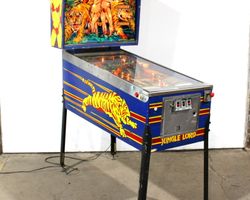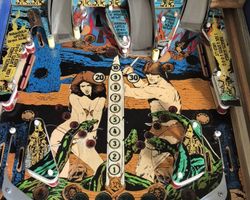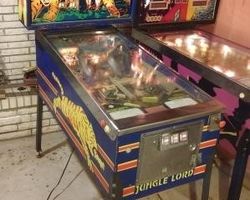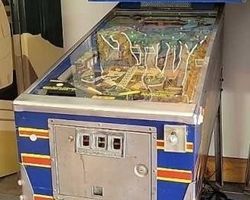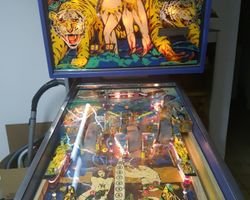Jungle Lord
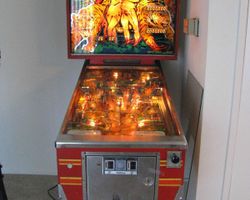
Average Prices: USD $300 to $1,100
Produced: Febuary, 1981
Production Run: 6,000 units
Machine Type: Solid State Electronic
MPU: Williams System 7
Players: 4
Design by: Barry Oursler
Art by: Constantino Mitchell, Jeanine Mitchell
Software by: Larry DeMar, Paul Dussault
Williams Electronic Games, Inc. introduced Jungle Lord in February 1981, a pinball machine that immersed players in a vibrant, untamed world. The game's theme, echoing classic adventure narratives of the jungle, captured the imagination with its depiction of primal forces and lush landscapes. This machine emerged during a prolific period for Williams, a time when the company was refining its approach to solid-state pinball design.
The creation of Jungle Lord was a collaborative effort by some of Williams' key talents. Barry Oursler, a designer known for his inventive layouts, conceived the playfield. The artistic vision for the machine, including its distinct cabinet and backglass imagery, was brought to life by Constantino Mitchell and Jeanine Mitchell, who rendered the untamed jungle environment. Larry DeMar was responsible for the software, programming the game's rules and interactive elements. A total of 6,000 units of Jungle Lord were produced, making it a significant release in Williams' System 7 generation of pinball machines. It notably stands as the second of four two-level System 7 games developed by Williams, a design philosophy that added depth and complexity to the gameplay.
An interesting aspect of Jungle Lord's production history involves its cabinet colors. Early production units, estimated at around 100 machines, featured a striking red cabinet. The majority of the production run, however, utilized a blue cabinet. Accompanying these color shifts were subtle artwork modifications, including minor adjustments to the backglass and some playfield colors. The "Magna-Save" text also moved from the right of each Magna-Save area to within the area itself on later blue cabinet versions. While a rumor of an extremely rare black cabinet version circulating in Germany in April 1981 exists, definitive confirmation and photographic evidence remain elusive. These production variations highlight the iterative nature of manufacturing and the small design changes that can occur during a game's run.
Signature Features and Design
Jungle Lord distinguishes itself through several unique elements, each contributing to its intense gameplay experience. Central to its design is the dual-level playfield, a hallmark of Williams' System 7 era that allowed for intricate shot geometries and dynamic ball movement. This split-level design elevates the challenge, requiring players to master shots that transition between the upper and lower areas.
A prominent feature is the Magna-Save, a player-controlled electromagnet system positioned in the outlanes. Activated by dedicated cabinet buttons, the Magna-Save allows players to potentially rescue a ball from draining, offering a crucial layer of control and strategic depth that was a departure from traditional drain mechanics. This innovation provides a fleeting moment of power, rewarding quick reflexes and precise timing.
Another notable design element is the "L-O-R-D" bagatelle, a pachinko-like mechanism located on the upper playfield. While it occupies a considerable space, its purpose is integral to initiating multiball. Balls entering specific saucers on the upper playfield are directed into this area, where their descent lights letters to spell L-O-R-D. This unique method for activating a core game feature adds a distinctive, somewhat unpredictable, dimension to the gameplay. The inclusion of custom speech, a novelty for its time, further enhanced the jungle theme, with phrases like "FIGHT JUNGLE TIGER AND WIN!" adding to the game's campy charm.
Playfield and Mechanics
The Jungle Lord playfield is a study in vertical integration, designed to keep the ball in constant motion between its two levels. The lower playfield serves as the primary action zone, equipped with two standard flippers for primary shots. Flanking these are left and right slingshots, which accelerate the ball unpredictably. Left and right inlanes are strategically placed to enable "Lower Loop" features and contribute to the "1-2-3-4-5" series. The left and right outlanes feature the crucial Magna-Save units, ready to be activated by the player's discretion. Two banks of three drop targets each are situated on the lower playfield; completing these banks awards a Magna-Save and starts a timer.
The upper playfield, accessed via ramps from below or the initial plunger launch, presents its own set of challenges. It features two smaller flippers, primarily used to navigate shots within this elevated section. Three ramps lead to the upper playfield: a left ramp, a right ramp that curves counter-clockwise, and a straight center ramp positioned between the upper flippers. This area also houses a bank of "1-2-3-4-5" standup targets, which, when completed, enable "double scoring." The unique L-O-R-D bagatelle mechanism is prominent here, along with an upper and a lower saucer that feed into it to progress the multiball objective. A five-bank drop target setup, known as "Double Trouble," adds another layer of scoring opportunity. The absence of traditional pop bumpers contributes to the game's swift, uninhibited flow, encouraging direct shots and a rapid pace. The artwork on the playfield, while sometimes debated for its style, consistently reinforces the jungle theme with vibrant, somewhat stylized depictions of flora and fauna.
Gameplay Dynamics
Jungle Lord's gameplay dynamics are built around a combination of timed modes, strategic shot-making, and the unique Magna-Save feature. The primary objective often revolves around initiating and maximizing the two-ball multiball. This mode is triggered by spelling "L-O-R-D," which can be achieved either by guiding balls through the upper playfield's L-O-R-D bagatelle mechanism or by completing the lower playfield's drop target banks (each bank lights one letter). Once L-O-R-D is spelled, locking a ball in an upper saucer initiates multiball. A 35-second timer begins, during which the player aims to re-spell L-O-R-D for bonus points. A ball saver mechanism during this initial phase allows a drained ball to be returned by locking the remaining ball, providing a brief reprieve.
Another significant scoring opportunity comes from the "Double Trouble" feature. This mode is activated by completing the upper five-bank drop target bank five times. Once active, a single drop target rises on the upper bank, accompanied by a timer. Hitting this target scores 10,000 points, and subsequent hits within the timer double the score (20K, 40K, 80K, 160K), creating a lucrative progressive scoring opportunity that carries over between balls. Strategic players aim to combine "Double Trouble" with multiball and "double scoring" (activated by completing the "1-2-3-4-5" standup targets) for high-score runs. The Magna-Save, awarded by hitting lower drop targets, offers critical ball-saving opportunities, giving players a chance to prevent frustrating drains and extend their gameplay, particularly during intense multiball sequences. Incrementing the bonus multiplier via the right lower loop is also a key strategy for maximizing end-of-ball scores. The game encourages an aggressive, fast-paced style, often demanding precise shots to the upper playfield and careful management of the Magna-Save to thrive in its challenging environment.
Reception and Legacy
Jungle Lord generally garners a positive reception within the pinball community, often described as a challenging and fast-paced game that provides lasting enjoyment. Many players view it as an underrated title, frequently drawing comparisons to Black Knight due to their shared dual-level playfield design and Magna-Save features. While some prefer one over the other, Jungle Lord is recognized as a robust machine from its era, one that encourages repeat play.
Among its strengths, players consistently highlight the game's demanding yet rewarding gameplay. The dual-level playfield contributes to a rapid flow, and the skill required to navigate its shots is a source of satisfaction. The Magna-Save feature is frequently lauded as an innovative and effective mechanic, granting players a degree of control over otherwise inevitable drains. The multiball, particularly the timed "Stampede" mode with its ball saver, is seen as an exciting and well-implemented component. The rule set, while not always immediately intuitive, offers surprising depth for a game of its vintage, rewarding players who invest time in understanding how to stack multipliers, modes, and multiball for maximum scoring. The sound package, while rudimentary, often evokes nostalgia, with many appreciating its campy charm, including the distinctive bell and buzzer effects.
However, Jungle Lord is not without its criticisms. The artwork is a point of contention for many, often described as peculiar or uninspired, particularly when compared to other machines of the period. The bagatelle mini-game is perhaps the most divisive feature; while some appreciate its originality in initiating multiball, many find it random, slow, or a break in the game's momentum, taking up valuable playfield space without consistently adding to the experience. Some critiques also point to a perceived lack of fluid flow, with an abundance of ramps leading to the upper playfield, potentially disrupting the rhythm. The game's difficulty, characterized by aggressive drains, especially from shots to the upper playfield and center ramp, is a common observation. Maintenance, typical for a System 7 era machine, can also be complex. Nevertheless, the development of community-created "home ROMs" or "New Tricks ROMs" has addressed some of these concerns, particularly improving control over the bagatelle.
Jungle Lord's legacy is that of a solid, albeit challenging, machine that represents a key period in Williams' design evolution. Its successful implementation of the dual-level playfield and the player-controlled Magna-Save influenced subsequent Williams titles, solidifying these features as staples for a time. It stands as a testament to the era's innovative spirit, demonstrating how designers pushed the boundaries of pinball mechanics to create more interactive and demanding gameplay experiences.
Sponsored Links
 Ebay Listings
Ebay Listings
 Auction Results
Auction Results
| Cost | Location | Date |
|---|---|---|
| GBP £646 |  Worksop, United Kingdom Worksop, United Kingdom |
26 March, 2025 |
| USD $1,500 |  Pennsylvania, United States Pennsylvania, United States |
07 May, 2024 |
| EUR €2,890 |  Baden-Württemberg, Germany Baden-Württemberg, Germany |
27 December, 2023 |
| USD $900 |  Indiana, United States Indiana, United States |
16 November, 2023 |
| GBP £1,039 |  United Kingdom United Kingdom |
04 September, 2023 |
| USD $1,995 |  Colorado, United States Colorado, United States |
16 May, 2023 |
| EUR €2,400 |  Nordrhein-Westfalen, Germany Nordrhein-Westfalen, Germany |
13 May, 2023 |
| USD $1,600 |  Illinois, United States Illinois, United States |
25 March, 2023 |
| USD $2,595 |  Colorado, United States Colorado, United States |
18 March, 2023 |
| USD $1,800 |  Texas, United States Texas, United States |
03 March, 2023 |


Private Policy · Search Website · Contact Us
As an eBay Partner, we may earn a commission from qualifying purchases made through links on this site, at no additional cost to you.
All trademarks and copyrighted materials remain property of their respective owners. All other content copyright 2007 - 2025 Pinpedia.

